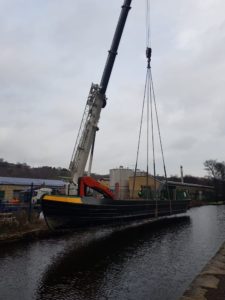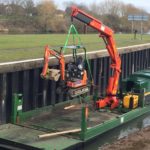Ian Rothen, Founder of The Rothen Group, explains the steps which should be put in place to ensure best practice when lifting.
Strict regulations are in place for manoeuvring materials or plant, given the serious risk this can pose to anyone on site if not done correctly. Known as the Lifting Operations and Lifting Equipment Regulations (LOLER), these guidelines ensure best practice is carried out when operating or supplying lifting equipment.
If your business or organisation undertakes lifting operations, or is involved in providing lifting equipment, it is your responsibility to manage and control the risks to protect those involved. This is especially true when carrying out work close to waterways, which can present further dangers. To ensure this is the case, guidelines must be adhered to and lifting operations must be planned properly. Failing to do so could result in serious injury if a load is not properly supported.

Appropriate equipment
In order to correctly prepare for lifting objects on site, a lifting plan must be completed, regardless of whether the risk involved is basic or complex, heavy, or light. A lifting plan provides details around the weight of the load being moved and the most appropriate safe working load (SWL) for the lifting accessory based on this. Lifting accessories such as shackles, straps or chains should all have the SWL stamped on them to provide guidance, this states the maximum safe force for lifting without breaking.
These lifting accessories are used to create a sling to move the load, the type of sling method used is dependent on the size and type of load as well as the environmental conditions in the area. It is therefore useful if personnel have the knowledge to plan for this and unexpected obstructions which may require the crane in use to lift at a different angle than previously planned. This can also impact what sling method should be used, including a vertical, choke or basket lift with a single or double leg sling.
In addition to requiring detail around the SWL in the lifting plan, the specific equipment used in conjunction with the accessories is also needed. Ensuring those on site fully understand how to select the most appropriate equipment for the job to include in the plan helps to avoid injuries. For example, at The Rothen Group (TRG), there is a fleet of certified lifting machines for waterside work – including cranes and diggers – all of which are capable of supporting varying load weights and attachments.
 Surroundings
Surroundings
Understanding how the type of ground that the operation will take place on can impact the risk involved is vital. Uneven or cracked ground, especially when close to rivers and canals, can pose a danger to the welfare of those on site, so needs to be carefully considered to avoid any accidents from happening. Maintaining these safe working conditions not only improves the organisation’s reputation, it also ensures the project runs on time, allowing further work to be taken on.
The weather also plays an important role as this can change the nature of the ground below the equipment being used. Factors such as wind and rain can affect the ground, as well as bankside and lifting conditions, which, in turn, may require site personnel to opt for different lifting equipment more suitable to the new situation. Having a team that can understand how the equipment needs to be adjusted in line with this makes the whole project run more efficiently and avoids delays, which is why training is so important.
In-depth training
As a leading marine construction and civil engineering company, TRG believes specialist training is crucial, especially on bankside work where bodies of water can present further challenges. Consequently, additional in-house training is given to members of the team – who are then known as ‘Lifting Legends’ – to act as consultants and ensure the safety of everyone on site, including non-TRG personnel. This scheme was introduced after it was recognised that there was a need to broaden this area of expertise, and that the level of awareness surrounding lifting could differ widely across multiple teams on any project.
The ‘Lifting Legends’ act as mentors, sharing their extensive knowledge with on-site contractors on how to safely lift loads while being aware of all of the variables involved. This also makes projects run more efficiently as they have the training to react to dynamic working conditions associated with sites. Whether there are roadworks to plan around or unpredictable weather to consider, they are able to accommodate this and ensure the ground is safe.









